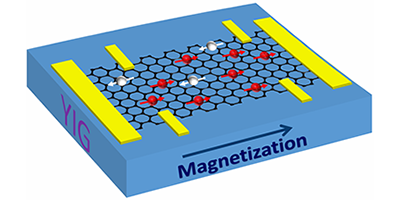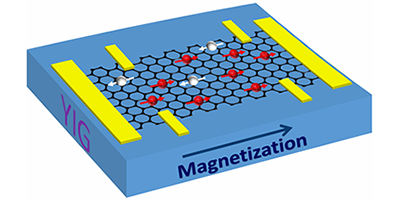Magnetic Graphene
While pristine sheets of graphene are intrinsically nonmagnetic, graphene can be made ferromagnetic by doping the material with magnetic impurities. However, the dopants can be detrimental to graphene’s highly sought-after electronic properties. Now Jing Shi and colleagues from the University of California, Riverside, have developed an alternative route to magnetizing a single sheet of graphene by bringing it into close proximity with a magnetic insulator. They show that this turns graphene into a ferromagnet, while preserving its large electron mobility.
In thin films like graphene, magnetism can be induced through proximity to a ferromagnet. However, if the latter is also a metal, as is often the case, it will short-circuit graphene, shunting any current away from it. To avoid this problem Shi and his group instead placed a single-layer graphene sheet on an insulating ferromagnetic substrate made of yttrium iron garnet (YIG). They confirmed that the presence of the substrate magnetized graphene while leaving its electronic properties unchanged.
To probe the magnetic state of graphene, the authors carried out Hall-effect measurements, in which a current passing through the material, under an applied magnetic field, induces a transverse voltage. The Hall effect occurs in any conducting material, but the observed behavior indicates an “anomalous Hall effect”—which is characteristic of ferromagnets. The measurements indicate that the induced ferromagnetic graphene state arises from spin polarization of its electrons due to coupling between electrons in the two materials. Shi et al. also observe that the coupling enhances graphene’s normally low spin-orbit coupling, which could allow the realization of exotic topological physics in the material.
This research is published in Physical Review Letters.
–Katherine Wright





